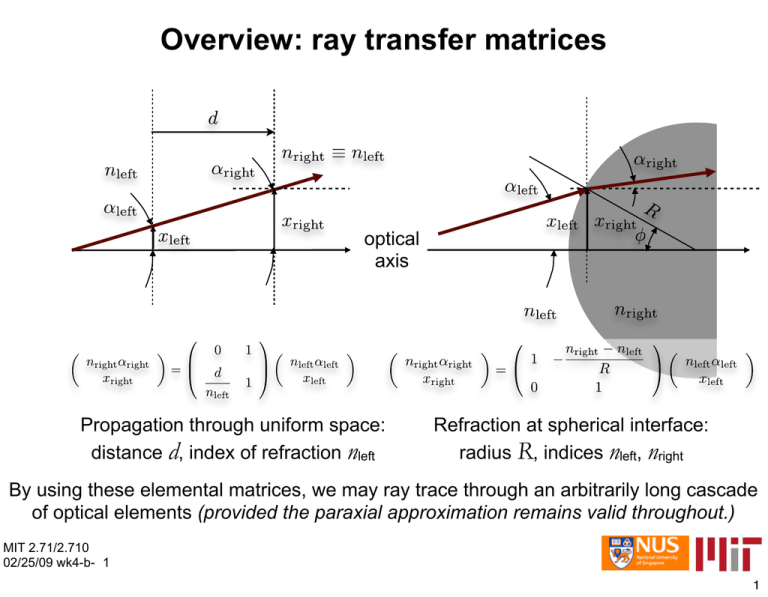
Overview: ray transfer matrices
optical
axis
Propagation through uniform space:
distance d, index of refraction nleft
Refraction at spherical interface:
radius R, indices nleft, nright
By using these elemental matrices, we may ray trace through an arbitrarily long cascade
of optical elements (provided the paraxial approximation remains valid throughout.)
MIT 2.71/2.710
02/25/09 wk4-b- 1
1
Overview: thin lens and object/image at infinity
object at infinity
image at infinity
MIT 2.71/2.710
02/25/09 wk4-b- 2
2
Overview: composite optical elements
ray from
infinity
FFP
BFP
FFL
1st
PP
then goes
through the BFP
BFP
bends at
1st PP
EFL
2nd
ray from
the FFP
FFP
BFL
EFL
bends at
2nd PP
1st PP
PP
1st PP
then goes
on to infinity
2nd PP
2nd PP
BFP
object
image
FFP
EFL
EFL
MIT 2.71/2.710
02/25/09 wk4-b- 3
3
Overview: real and virtual images
object
+
image
+
object
image
BFP
FFP
image: real & inverted; MT<0
image
object
object
BFP
image: virtual & erect; MT>1
image
–
FFP
image: virtual & erect; 0<MT<1
BFP
FFP
BFP
–
FFP
image: virtual & erect; 0<MT<1
MIT 2.71/2.710
02/25/09 wk4-b- 4
4
Overview: apertures, stops, pupils, windows
C.R
. fro
mo
bje
FoV
ct a
t fie
ld e
xis object
n-a
M.R. from o
dge
2nd FP
NA
1st FP
Exit
pupil
(virtual)
Entrance
Window
Aperture
Stop
& Entrance
Pupil
Field Stop
& Exit Window
MIT 2.71/2.710
02/25/09 wk4-b- 5
5
Today
•
•
Ray optics of mirrors
• [[ Some terminology:
– catoptric ≡ utilizing mirrors
κάτοπτρον (kátoptron) = mirror
– dioptric ≡ utilizing refractive lenses
δίοπτρον (díoptron) = lens
– catadioptric ≡ utilizing both mirrors and refractive lenses]]
The basic optical imaging systems
– magnifier lens
– eyepiece
– microscope
– telescope
• refractive: Keppler (dioptric)
• reflective: Cassegrain (catoptric)
• Schmidt (catadioptric)
MIT 2.71/2.710
02/25/09 wk4-b- 6
6
Sign conventions for catoptric optics
• Light travels from left to right before reflection and from right to left after
reflection
• A radius of curvature is positive if the surface is convex towards the left
• Longitudinal distances before reflection are positive if pointing to the right;
longitudinal distances after reflection are positive if pointing to the left
• Longitudinal distances are positive if pointing up
• Ray angles are positive if the ray direction is obtained by rotating the +z axis
counterclockwise through an acute angle
positive
direction
(after
reflection)
positive
ray angle
positive
ray angle
positive
ray elevation
positive
direction
(before
reflection)
positive
curvature
MIT 2.71/2.710
02/25/09 wk4-b- 7
7
Object/image at infinity with spherical mirror
object
at ∞
image
Object at infinity
image
at ∞
object
⇒Focal length
MIT 2.71/2.710
02/25/09 wk4-b- 8
Image at infinity
8
Catoptric imaging formulae
object/
image
image/
object
at ∞
Object/image at infinity
Focal length
Ray transfer
matrix
object
image
Object, image at finite distances
Imaging condition
Magnification
MIT 2.71/2.710
02/25/09 wk4-b- 9
9
The single lens magnifier
object at near point (25cm)
➙maximum unaided magnification
Magnifying power
eye
lens
real
image
at retina
Near point
virtual image
(erect and magnified)
magnifier
lens
real (magnified)
image
at retina
MIT 2.71/2.710
02/25/09 wk4-b-10
10
Eyepiece
• also known as “ocular”
• Magnifier meant to look at the intermediate image formed by the
preceding optical instrument:
– eye looks into eyepiece
– eyepiece “looks” into optical system (microscope, telescope, etc.)
• Ideally should
– produce a virtual image at infinity (⇒ MP=doP)
• the final image is viewed with relaxed (unaccommodated) eye
– center the exit pupil (eye point) where the observer’s eye is placed
at 10mm (eye relief) from the instrument
MIT 2.71/2.710
02/25/09 wk4-b- 11
Fig. 5.93 in Hecht, Eugene. Optics. Reading, MA: Addison-Wesley, 2001.
ISBN: 9780805385663. (c) Addison-Wesley. All rights reserved. This content is excluded
from our CreativeCommons license. For more information, see http://ocw.mit.edu/fairuse.
11
Microscope
•
•
Exit Pupil
Eyepiece
Purpose: to “magnify” thereby providing additional detail on
a small, nearby object
Objective lens followed by an eyepiece
– Objective: forms real, magnified image of the object at
the plane where the instrument’s field stop is located
– Eyepiece: its object plane is the objective’s image plane
and forms a virtual image at infinity
➡ magnified image can be viewed with relaxed
(unaccommodated) eye
➡ compound magnifying power is the product of the
magnifications of the two elements, i.e.
Field Stop
Aperture
Stop
MIT 2.71/2.710
02/25/09 wk4-b-12
•
The distance from the BFP of the objective to the FFP of the
eyepiece is known as tube length and is standardized at
160mm.
•
The near point used as do is standardized at 254mm
(10 inches.)
Entrance
Pupil
Fig. 5.99 in Hecht, Eugene. Optics. Reading, MA: Addison-Wesley, 2001.
ISBN: 9780805385663. (c) Addison-Wesley. All rights reserved. This content is excluded
from our CreativeCommons license. For more information, see http://ocw.mit.edu/fairuse.
12
MIT OpenCourseWare
http://ocw.mit.edu
2.71 / 2.710 Optics
Spring 2009
For information about citing these materials or our Terms of Use, visit: http://ocw.mit.edu/terms.

